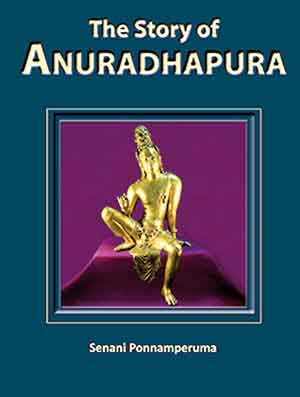The rise and fall of a great civilisation captured poetically
View(s):Senani Ponnampe-ruma, has done it again—turning the fascinating history of the Anuradhapura Kingdom into an exquisitely crafted book for all to enjoy. “The Story of Anuradhapura” is scholastic, immensely readable, but most of all, beautiful in its poetic descriptions of this sophisticated ancient kingdom. The book is also filled with stunning photographs from the modern day site, as well as rare glimpses of some of its magnificent ancient artifacts.
 The Story of Anuradhapura is divided into three parts. In part one, Ponnamperuma outlines the 1,500 year-long trajectory of the Anuradhapura Kingdom. In many instances, for the benefit of readers not familiar with the history of this kingdom, he provides universal context to his story. For example, the author describes the story of Vijaya and his abandonment of his consort Kuveni, as being similar to the tale of Ulysses and Circe in Homer’s Odyssey. Ponnamperuma also briefly describes the oppressive rule of Cora-naga, which ended in his wife, the first queen of the kingdom, poisoning him. For readers to imagine the other global events around the time of Cora-naga’s hideous reign, he mentions that it was about this time that Jesus Christ was born in Palestine. Once readers have this foundational understanding of the kingdom’s timeline, rulers and events; it is easy for them to become enticed by the second part of the book, in which the author reveals many cultural and lifestyle factors that shaped the kingdom.
The Story of Anuradhapura is divided into three parts. In part one, Ponnamperuma outlines the 1,500 year-long trajectory of the Anuradhapura Kingdom. In many instances, for the benefit of readers not familiar with the history of this kingdom, he provides universal context to his story. For example, the author describes the story of Vijaya and his abandonment of his consort Kuveni, as being similar to the tale of Ulysses and Circe in Homer’s Odyssey. Ponnamperuma also briefly describes the oppressive rule of Cora-naga, which ended in his wife, the first queen of the kingdom, poisoning him. For readers to imagine the other global events around the time of Cora-naga’s hideous reign, he mentions that it was about this time that Jesus Christ was born in Palestine. Once readers have this foundational understanding of the kingdom’s timeline, rulers and events; it is easy for them to become enticed by the second part of the book, in which the author reveals many cultural and lifestyle factors that shaped the kingdom.
In part three of the book the Ponnamperuma provides a guide to the modern-day ruins of Anuradhapura, skilfully connecting the vestiges of the ancient structures that still remain today to the rulers who constructed them.
Ponnamperuma starts his story of this ancient kingdom with the foundational myth of Vijaya (483 BC), the totemic leader of the Sinhalese people. Here he describes the backstory of Vijaya’s grandmother, Suppadevi, a free-spirited princess whom soothsayers predicted would “consummate a union with a lion.” In this alluring tale, Suppadevi mothers two children with a lion, and her son, Sinhabahu goes on to kill his lion father. After sending readers on the journey of this intriguing fable, the author then explains how this tale most likely came to be: Suppadevi was probably kidnapped by a bandit whose name, “Sinha,” meant lion.
At times, the book takes on a dreamy air, as the narrative reflects on the kingdom’s golden ages and its peoples’ Buddhist beliefs that inspired them to engage in projects that glorified their religion, avoiding bearing arms and maintaining an army. Though the kingdom flourished and was rooted in Buddhism, it was no stranger to scandal, tragedy, and other hardships. The descriptions of these difficulties stimulate the reader’s imagination, providing stark contrast to the more whimsical moments in the text.
Ponnamperuma does a masterful job of outlining the contributions that the various rulers made to the kingdom over a vast timeline. In a narrative of cause-and-effect, he describes leaders such as Devanampiya-tissa (247 BC) who introduced Buddhism to the kingdom, Vattagamini-abhaya and Mahasena who constructed the largest brick structures ever built, through the sad tale of Dhatusena and his son Kasyapa (448 AD) the builder of the magnificent Sky Palace of Sigiriya. He also describes the extraordinary feats of Manavamma, (676 AD) who brought about the kingdom’s revival after a devastating civil war of nearly two centuries.
When Ponnamperuma describes the eventual demise of this beautiful kingdom readers are left devastated. This is a result of Ponnamperuma’s lucid descriptions, not only of the many transformational events that Anuradhapura underwent, but also because readers are so easily transported, by the author’s descriptions, into this ancient world and are witness to the heart-wrenching destruction of a great civilization.
Ponnamperuma asserts that the fall of the Anuradhapura Kingdom involved higher levels of complexity than most people believe. The commonly held theory for the kingdom’s downfall is that the Chola ruler of South India, Rajaraja, invaded and devastated the island. While this is partially true, Ponnamperuma reminds readers that this explanation is an oversimplification. Far more divisive events had been at play that undermined the kingdom’s capacity to fend off an invasion from India. For example, he explains how the very last king, Mahinda V (986 AD), had inherited a kingdom in a state of utter turmoil, and despite his efforts, the kingdom was disintegrating and too feeble to resist collapse.
In the second part of the book the author reveals the many societal, religious and lifestyle factors that shaped the kingdom. He paints a picturesque image of a very unique society, while maintaining his factual tone. As he speaks of the island’s “excellent natural harbours,” its exports of “gems, spices, pearls, elephants, ivory, and tortoise, turtle, and conch shells,” the reader gets an appreciation of the kingdom’s wealth and prestige.
Part three of the book provides a guide to the modern-day ruins of Anuradhapura as the author deftly connects the vestiges of the ancient structures that still remain today to the rulers who constructed them.
| Book facts | |
| The Story of Anuradhapura -by Senani Ponnamperuma. Reviewed by Marcole |
| About the author | |
 Senani Ponnamperuma was born in Sri Lanka, educated in the US and now resides in Australia. He is a member of the illustrious Ponnamperuma family that included scientists Cyril, Felix and Lakshman Ponnamperuma. Prior to commencing his career as an author, Senani had a successful career in IT. He was the Chief Information Officer (CIO) of two large Australian retailers. He is also acknowledged as being the first to successfully introduce barcode scanning technologies into Australian supermarkets. Senani Ponnamperuma was born in Sri Lanka, educated in the US and now resides in Australia. He is a member of the illustrious Ponnamperuma family that included scientists Cyril, Felix and Lakshman Ponnamperuma. Prior to commencing his career as an author, Senani had a successful career in IT. He was the Chief Information Officer (CIO) of two large Australian retailers. He is also acknowledged as being the first to successfully introduce barcode scanning technologies into Australian supermarkets. Senani Ponnamperuma has now combined his love of literature and Sri Lankan history to produce well- researched easy-to-read books on the history of Sri Lanka. The first, The Story of Sigiriya, is a truly comprehensive account of one of the most fascinating historic sites in the world. The second, The Story of Anuradhapura, is an equally interesting history of the Anuradhapura Kingdom. Most recently Ponnamperuma’s book The Story of Sigiriya was presented at the 2017 Beijing Book Fair on behalf of the Sri Lanka Embassy. |


